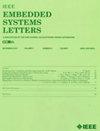用于未来移动 DNA 检测的 SoC 设计
IF 1.7
4区 计算机科学
Q3 COMPUTER SCIENCE, HARDWARE & ARCHITECTURE
引用次数: 0
摘要
现有的微型 DNA 测序设备很有希望成为未来的移动/个人基因组分析系统。但实现这一愿景的关键挑战在于测序设备本身缺乏足够的低功耗生物信息计算能力。在这封信中,我们讨论并演示了基于加速 RISC-V 内核的片上系统 (SoC),以完成这样的任务。该芯片采用 22 纳米 CMOS 制造,在 DNA 序列检测任务上的执行速度比商用移动处理器快近 10 倍,同时能效比商用处理器高 200 倍。本文章由计算机程序翻译,如有差异,请以英文原文为准。
An SoC Design for Future Mobile DNA Detection
Existing miniature DNA sequencing devices hold significant promise to serve as mobile/personal genomic analysis systems in the future. But a key challenge to this vision is the absence of adequate low-power bioinformatic computing ability within the sequencing device itself. In this letter, we discuss the design and demonstrate a system-on-chip (SoC) based on an accelerated RISC-V core for such a task. The chip was fabricated in 22-nm CMOS and executes almost
$10\times $
faster than a commercial mobile processor on a DNA sequence detection task while achieving
$200\times $
better energy efficiency.
求助全文
通过发布文献求助,成功后即可免费获取论文全文。
去求助
来源期刊

IEEE Embedded Systems Letters
Engineering-Control and Systems Engineering
CiteScore
3.30
自引率
0.00%
发文量
65
期刊介绍:
The IEEE Embedded Systems Letters (ESL), provides a forum for rapid dissemination of latest technical advances in embedded systems and related areas in embedded software. The emphasis is on models, methods, and tools that ensure secure, correct, efficient and robust design of embedded systems and their applications.
 求助内容:
求助内容: 应助结果提醒方式:
应助结果提醒方式:


